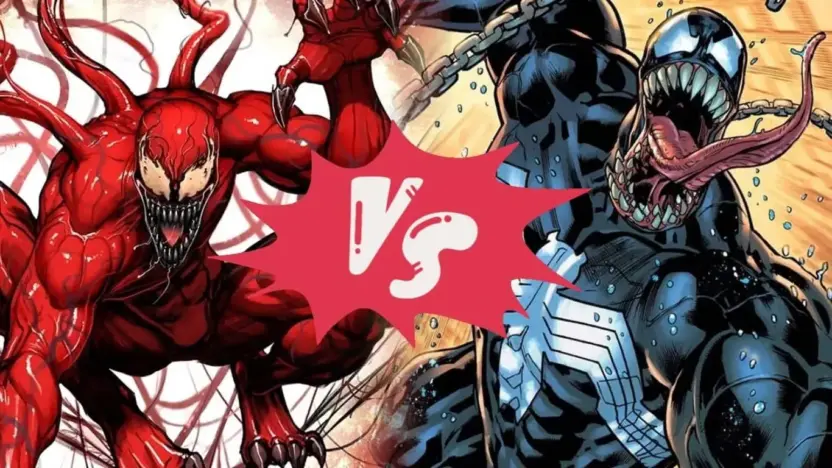10 Things That Make Carnage Different From Venom: In the sprawling universe of Marvel Comics, few antagonists are as chillingly distinctive as the symbiotes, and among them, Venom and Carnage stand out as two of the most iconic. While they share a lineage, with Venom giving birth to Carnage, their differences are stark and intriguing. To the casual observer, they might appear similar—sinister alien entities that merge with human hosts. However, a deeper dive reveals a labyrinth of variances, from their origins to their motivations. In this article, we’ll delineate ten critical differences between these two menacing symbiotes, shedding light on the factors that make Carnage not just another Venom offspring, but a unique terror in his own right.
10 Things That Make Carnage Different From Venom
Origin
Within the dark and intricate realm of Marvel’s symbiotes, understanding the roots of each entity is crucial. The first and perhaps most fundamental difference between Carnage and Venom lies in their origins. Venom, a pioneering symbiote in the Marvel narrative, initially bonded with Spider-Man and later, most notably, with Eddie Brock. Its existence in the comics paved the way for subsequent symbiotes.
Carnage, on the other hand, emerged as a direct offspring of Venom. When Venom attempted a prison break with Eddie, it inadvertently left behind a progeny. This offspring found a host in Cletus Kasady, a notorious serial killer. This stark difference in origin sets the stage for their divergent paths: while Venom grapples with moral ambiguities, Carnage, influenced by Kasady’s dark psyche, represents chaos incarnate.
Host
While the symbiotes themselves possess inherent traits, it’s the nature of their human hosts that often amplifies or reshapes their tendencies. Venom’s most iconic bond is with Eddie Brock, a disgraced journalist whose complexities give the symbiote a blend of vengeance and, occasionally, heroism. Their relationship is multifaceted, veering between anti-hero antics and outright villainy.
In stark contrast, Carnage bonds with Cletus Kasady, a man whose psyche was already drenched in chaos. A sadistic serial killer, Kasady’s union with Carnage is a merger of two entities that revel in bloodlust and pandemonium. This deep-rooted difference in their human counterparts shapes the narratives of Venom and Carnage, with Brock’s internal moral battles juxtaposing sharply against Kasady’s unapologetic descent into malevolence.
Physical Appearances
The physical appearances of Venom and Carnage, while bearing familial resemblances as symbiotes, have marked differences that visually set them apart in the Marvel Universe. Venom is characterized by its imposing, muscle-bound form, predominantly black in color with a white, spider-like emblem sprawled across its chest, a nod to its early bond with Spider-Man. Its eyes are white, almond-shaped, and often convey a menacing look.
Conversely, Carnage sports a more slender and sinewy build, awash with a deep red hue interspersed with black tendrils that give it an appearance reminiscent of swirling blood. Its eyes are usually more jagged and chaotic than Venom’s, reflecting its unpredictable nature. These stark contrasts in physicality not only help fans instantly distinguish one from the other but also mirror the inherent differences in their personas and narratives.
Children
Both Venom and Carnage have given rise to progeny, but their children reflect their distinct narratives and personalities. Venom’s most infamous offspring is Carnage itself. Abandoned during a prison break, this new symbiote found its perfect partner in Cletus Kasady, leading to a bond that would rival Venom’s own ferocity.
Carnage, in its own right, later becomes a “parent” when it gives birth to Toxin, another symbiote with unique abilities and an even more conflicted relationship with its host. The lineage and relationships between these symbiotes and their hosts add layers of complexity to their stories. The birth of each new generation carries forward themes of legacy, rivalry, and identity, further distinguishing each symbiote within the vast Marvel cosmos.
Physical Strength
Strength is a defining factor when it comes to the rivalry between Venom and Carnage, and it’s a point of contention that often tips in Carnage’s favor. While both symbiotes grant their hosts superhuman abilities, Carnage has frequently been depicted as the mightier of the two. The seamless and intimate bond it shares with the unhinged Cletus Kasady allows for a near-perfect synthesis of host and symbiote, unlocking a greater potential for raw power.
Furthermore, as a direct offspring of Venom, Carnage benefits from a kind of “evolutionary advancement.” It’s akin to the next generation in technology – building upon the foundation of its predecessor but arriving with enhancements. This superior strength, combined with Kasady’s sadistic nature, positions Carnage as a formidable and often overpowering adversary, even for Venom.
Creation Powers
In the vast symbiotic arsenal of abilities, one trait that sharply distinguishes Carnage from Venom is its power of creation. While both symbiotes can shape-shift and morph to some extent, Carnage takes this to a new level. It possesses the unique ability to fashion parts of its body into weaponry and tools. From producing razor-sharp tendrils and bladed weapons to forming protective shields, Carnage’s morphing prowess showcases its innate ingenuity in combat.
Moreover, the fluidity with which Carnage generates these tools on the fly is a testament to its refined bond with Kasady and its evolution as a symbiote. Venom, on the other hand, while highly adaptive, doesn’t typically exhibit such a pronounced capacity for spontaneous weapon creation. This particular power accentuates Carnage’s threat level, making it an even more unpredictable and versatile foe in battle.
Bond with Host
The bond a symbiote shares with its host is crucial in defining its behaviors, abilities, and overall psyche. For Venom and Carnage, these relationships are as contrasting as they are intimate. Venom, especially when merged with Eddie Brock, experiences a duality — it’s a partnership, a “we.” They often converse, negotiate, and even argue, indicating two distinct entities striving for common ground. This shared control sometimes leads to inner conflict, with Eddie’s human morals clashing against the symbiote’s primal desires.
In stark contrast, the union between Carnage and Cletus Kasady is hauntingly seamless. Their bond is so profound and complete that they often refer to themselves as “I.” This suggests an almost singular entity, with the psychopathic nature of Kasady perfectly meshing with the chaotic inclinations of the Carnage symbiote. This unparalleled synchronization makes their bond deeper, rendering them a singular force of unbridled malevolence.
Carnage Has Never Bonded With Peter Parker
The symbiotic relationships in the Marvel Universe often shift, creating new dynamics and story arcs. One notable fact is that while Venom originally bonded with Peter Parker (Spider-Man) before finding its way to Eddie Brock, Carnage has never formed such a bond with Peter. This distinction is crucial for several reasons:
Spider-Man’s initial bond with the Venom symbiote directly affected his relationship with Eddie Brock, forging a complicated triangle of love, hate, and revenge. This dynamic has led to various storylines where Venom fluctuates between being Spider-Man’s adversary and ally.
Carnage, not having bonded with Peter, lacks the personal vendetta that Venom carries. Its motivations are more rooted in pure chaos and destruction, fueled by Kasady’s psychopathic tendencies. This makes Carnage’s relationship with Spider-Man different, focused more on the sheer threat Carnage poses rather than a personal enmity. In essence, while Spider-Man and Venom share a tangled web of personal history, Carnage’s interaction with Spider-Man is more straightforwardly antagonistic, driven by its nature and Kasady’s innate desire for mayhem.
Regeneration
Venom possesses a potent healing factor. It can recover from wounds rapidly, heal its host from injuries, and even help regenerate lost limbs or organs. This regenerative power has been a saving grace for Eddie Brock on numerous occasions, fortifying the symbiote’s utility beyond mere strength and aggression.
Carnage, on the other hand, has displayed a superior level of regenerative capability. Given its evolutionary advancement over Venom, Carnage can heal at an even faster rate. This enhanced regeneration, combined with its already superior strength and bond with Kasady, makes Carnage a particularly resilient adversary. Even when faced with seemingly mortal injuries, Carnage’s ability to bounce back often tilts the scales in its favor during battles, further highlighting the menace it presents to foes, including Venom and Spider-Man.
Moral Code and Views on Humanity
Rooted in its bond with Eddie Brock, Venom’s perspective is tinted with a rugged moral code. This symbiote, while aggressive, often leans towards an anti-hero stance, driven by a desire to protect the vulnerable. Eddie’s human sensibilities have imbued Venom with a duality: a balance between viewing humanity as both a threat and a responsibility. This has crafted Venom into a complex figure, one that juggles its primal urges with Brock’s ingrained sense of justice.
Where as Carnage, influenced profoundly by Cletus Kasady’s sadistic nature, embodies pure chaos. Devoid of a traditional moral compass, it revels in mindless destruction and mayhem. Humanity, in Carnage’s eyes, is little more than a canvas for its malevolent exploits, making it a force of unchecked menace, unconcerned with distinctions of right or wrong.
Also Read: 10 Most Impactful Events in Marvel Comics



